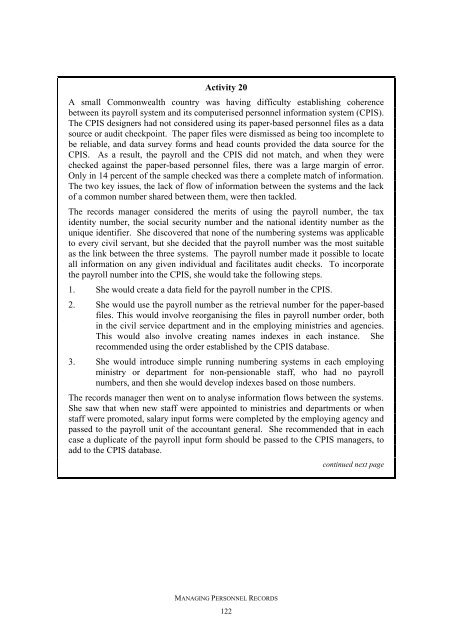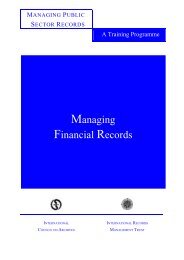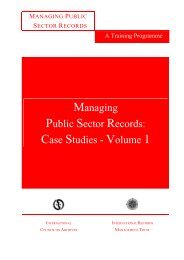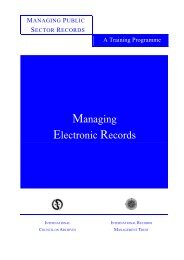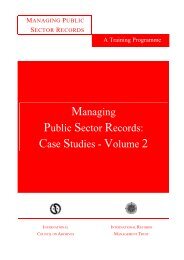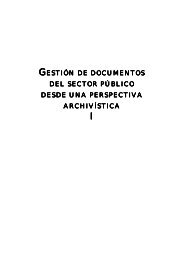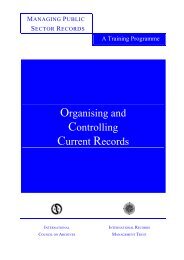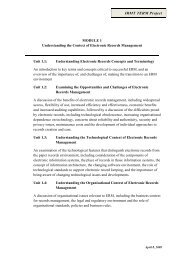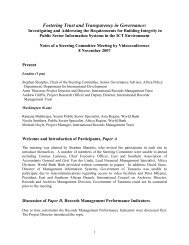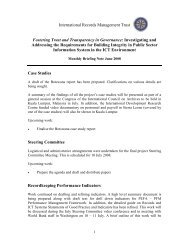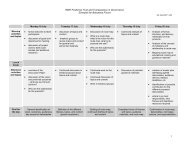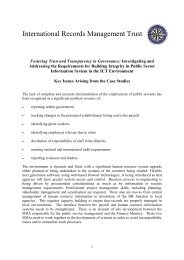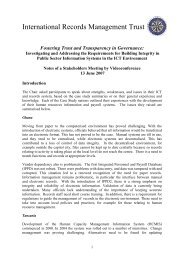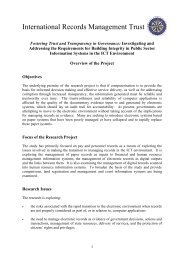Managing Personnel Records - International Records Management ...
Managing Personnel Records - International Records Management ...
Managing Personnel Records - International Records Management ...
You also want an ePaper? Increase the reach of your titles
YUMPU automatically turns print PDFs into web optimized ePapers that Google loves.
Activity 20<br />
A small Commonwealth country was having difficulty establishing coherence<br />
between its payroll system and its computerised personnel information system (CPIS).<br />
The CPIS designers had not considered using its paper-based personnel files as a data<br />
source or audit checkpoint. The paper files were dismissed as being too incomplete to<br />
be reliable, and data survey forms and head counts provided the data source for the<br />
CPIS. As a result, the payroll and the CPIS did not match, and when they were<br />
checked against the paper-based personnel files, there was a large margin of error.<br />
Only in 14 percent of the sample checked was there a complete match of information.<br />
The two key issues, the lack of flow of information between the systems and the lack<br />
of a common number shared between them, were then tackled.<br />
The records manager considered the merits of using the payroll number, the tax<br />
identity number, the social security number and the national identity number as the<br />
unique identifier. She discovered that none of the numbering systems was applicable<br />
to every civil servant, but she decided that the payroll number was the most suitable<br />
as the link between the three systems. The payroll number made it possible to locate<br />
all information on any given individual and facilitates audit checks. To incorporate<br />
the payroll number into the CPIS, she would take the following steps.<br />
1. She would create a data field for the payroll number in the CPIS.<br />
2. She would use the payroll number as the retrieval number for the paper-based<br />
files. This would involve reorganising the files in payroll number order, both<br />
in the civil service department and in the employing ministries and agencies.<br />
This would also involve creating names indexes in each instance. She<br />
recommended using the order established by the CPIS database.<br />
3. She would introduce simple running numbering systems in each employing<br />
ministry or department for non-pensionable staff, who had no payroll<br />
numbers, and then she would develop indexes based on those numbers.<br />
The records manager then went on to analyse information flows between the systems.<br />
She saw that when new staff were appointed to ministries and departments or when<br />
staff were promoted, salary input forms were completed by the employing agency and<br />
passed to the payroll unit of the accountant general. She recommended that in each<br />
case a duplicate of the payroll input form should be passed to the CPIS managers, to<br />
add to the CPIS database.<br />
MANAGING PERSONNEL RECORDS<br />
122<br />
continued next page


